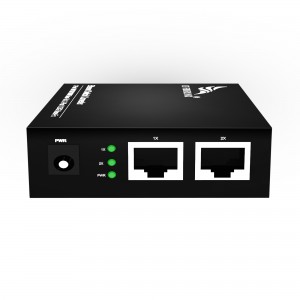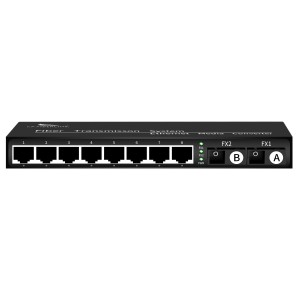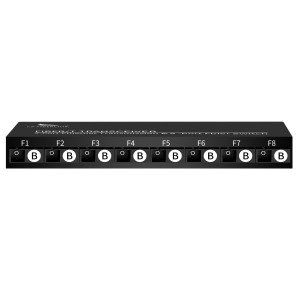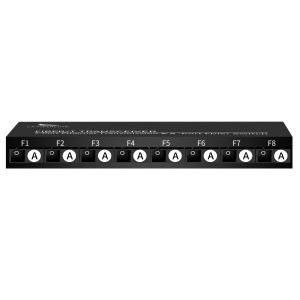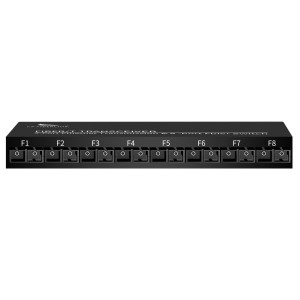2-port 10/100/1000M Media Converter (Single-mode Dual-fiber SC)
2-port 10/100/1000M Media Converter (Single-mode Dual-fiber SC)
Product Features:
Introduce a new generation of cutting-edge technology from Huizhou Changfei Optoelectronics Technology Co., Ltd., a leading innovator in high-tech enterprises – a card-type 1 optical 1 electrical single-mode dual-fiber optical fiber to serial port converter.
As the need for faster, more efficient data transfers continues to grow, we recognize the importance of providing reliable and adaptable solutions. With this in mind, our team of experts has developed a revolutionary product that combines the functionality of a fiber optic transceiver module and a media converter chassis into one compact and versatile device.
This fiber-to-serial converter features an SC interface for seamless integration into your existing network infrastructure. Whether you need to transmit data over long distances or connect multiple devices, our products provide the flexibility needed to meet your specific requirements.
One of the standout features of our fiber optic serial converters is their dynamic LED indicators, which provide real-time feedback on the status of the device. This allows for easy troubleshooting and monitoring, ensuring your network is always up and running.
Another major advantage of our product is its ease of use. Installation and configuration is a breeze thanks to our plug and play functionality. No extensive technical knowledge or complex setup procedures are required. Just connect the converter to your network to get started.
At Huizhou Changfei Photoelectric Technology Co., Ltd., we are committed to providing high-quality products that exceed our customers’ expectations. Our fiber optic serial converters are no exception. Utilizing the latest technology and rigorous manufacturing standards, you can trust our products will provide reliable performance, exceptional durability and a long service life.
With a focus on customer satisfaction, we offer unrivaled technical support and a team of professionals ready to help you. From product consultation to after-sales service, we are committed to ensuring that our customers have a seamless experience with our products.
In today’s fast-paced and data-driven world, having a reliable and efficient network infrastructure is critical. With Huizhou Changfei Optoelectronics Technology Co., Ltd. card-style 1 optical 1 electrical single-mode dual-fiber fiber optic to serial converter, you can stay ahead of the curve and harness the power of fiber optic technology for all your data transmission needs.
Experience the future of the web with us. Contact us today to learn more about our cutting-edge products and how we can help your business thrive in the digital age.
What This Product Does
◇ The CF-102GSK-20 is a media converter designed to convert 1000BASE-X fiber to 1000Base-T copper media or vice versa. Designed under IEEE802.3ab 1000Base-T and IEEE802.3z1000Base-X standards, the CF-102GSK-20 is designed for use with single-mode fiber cable utilizing the SC-Type connector. The CF-102GSK-20 supports longwave laser specification at a full wire speed forwarding rate. It works at 1310nm on both transmitting and receiving data.
◇ Other features of this module include the ability to be used as a stand alone device (no chassis required), Auto MDI/MDI-X for TX port, and front panel status LEDs. The CF-102GSK-20 will transmit at extended fiber optic distances utilizing single-mode fiber up to 20 kilometers.
Other Features
◇ Besides, this media converter can be used as a standalone device (no rack required) or used with CF FIBERLINK’s CF-2U16 rack for auto MDI/MDI-X in TX port in which duplex mode is automatically negotiated.
technical parameter:
|
Model |
CF-102GSK-20 | |
| Interface Characteristics | ||
|
Fixed Port |
1* 10/ 100/ 1000Base-T RJ45 port 1* 1000Base-X uplink SC fiber port |
|
|
Ethernet Port |
10/ 100/ 1000Base-T auto-sensing, full/half duplex MDI/MDI-X self-adaption |
|
|
Twisted Pair Transmission |
10BASE-T: Cat3,4,5 UTP(≤100 meter) 100BASE-T: Cat5e or later UTP(≤100 meter) 1000BASE-T : Cat5e or later UTP(≤100 meter) |
|
| Optical Port | Default optical module is single-mode dual-fiber 20km, SC port | |
| Wavelength/Distance | single mode: 1310nm 0~40KM ,1550nm 0~120KM | |
| Chip Parameter | ||
| Network Protocol | IEEE802.3 10BASE-T, IEEE802.3i 10Base-T,
IEEE802.3u 100Base-TX, IEEE802.3u 100Base-FX, IEEE802.3x IEEE802.3ab 1000Base-T;IEEE802.3z 1000Base-X; |
|
|
Forwarding Mode |
Store and Forward(Full Wire Speed) |
|
|
Switching Capacity |
4Gbps |
|
|
Buffer Memory |
3Mpps | |
|
MAC |
2K | |
|
LED Indicator |
Fiber | FX(green) |
| Data | TP (green) | |
| Single / duplex | FDX (green) | |
| Power | PWR (green) | |
| Power | ||
| Working Voltage |
AC:100-240V |
|
|
Power Consumption |
Standby<1W, Full load<5W |
|
|
Power Supply |
DC:5V/2A industrial power supply |
|
| Lightning protection &Certification | ||
| Lightning protection | Lightning protection: 4KV 8/20us, Protection level: IP30 | |
| Certification | CCC;CE mark, commercial; CE/LVD EN60950;FCC Part 15 Class B; RoHS | |
| Physical Parameter | ||
| Operation TEMP | -20~+55°C;5%~90% RH Non condensing | |
| Storage TEMP |
-40~+85°C;5%~95% RH Non condensing |
|
| Dimension (L*W*H) | 98mm*75mm*2mm | |
| Installation | Desktop, CF-2U16 slot rack | |
Product Size:
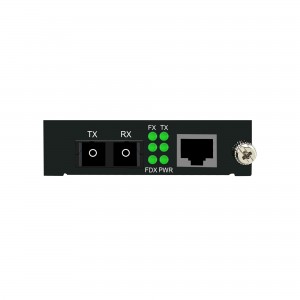
Product application diagra:

How to choose a fiber optic transceiver?
Optical fiber transceivers break the 100-meter limitation of Ethernet cables in data transmission. Relying on high-performance switching chips and large-capacity caches, while truly achieving non-blocking transmission and switching performance, they also provide balanced traffic, isolation and conflict. Error detection and other functions ensure high security and stability during data transmission. Therefore, fiber optic transceiver products will still be an indispensable part of actual network construction for a long time. So, how should we choose fiber optic transceivers?
1. Port function test
Mainly test whether each port can work normally in the duplex state of 10Mbps, 100Mbps and half-duplex state. At the same time, it should be tested whether each port can automatically select the highest transmission speed and automatically match the transmission rate of other devices. This test can be included in other tests.
2. Compatibility test
It mainly tests the connection ability between the optical fiber transceiver and other devices compatible with Ethernet and Fast Ethernet (including network card, HUB, Switch, optical network card, and optical switch). The requirement must be able to support the connection of compatible products.
3. Cable connection characteristics
Test the fiber optic transceiver’s ability to support network cables. First, test the connection ability of Category 5 network cables with lengths of 100m and 10m, and test the connection ability of long Category 5 network cables (120m) of different brands. During the test, the optical port of the transceiver is required to have a connection capability of 10Mbps and a rate of 100Mbps, and the highest must be able to connect to a full-duplex 100Mbps without transmission errors. Category 3 twisted pair cables may not be tested. Subtests can be included in other tests.
4. Transmission characteristics (transmission loss rate of data packets of different lengths, transmission speed)
It mainly tests the packet loss rate when the optical fiber transceiver optical port transmits different data packets, and the connection speed under different connection rates. For the packet loss rate, you can use the test software provided by the network card to test the packet loss rate when the packet size is 64, 512, 1518, 128 (optional) and 1000 (optional) bytes under different connection rates. , the number of packet errors, the number of packets sent and received must be more than 2,000,000. Test transmission speed can use perform3, ping and other software.
5. The compatibility of the whole machine to the transmission network protocol
It mainly tests the compatibility of fiber optic transceivers to network protocols, which can be tested in Novell, Windows and other environments. The following low-level network protocols such as TCP/IP, IPX, NETBIOS, DHCP, etc. must be tested, and the protocols that need to be broadcast must be tested. Optical transceivers are required to support these protocols (VLAN, QOS, COS, etc.).
6. Indicator status test
Test whether the status of the indicator light is consistent with the description of the panel and the user manual, and whether it is consistent with the current status of the fiber optic transceiver.








